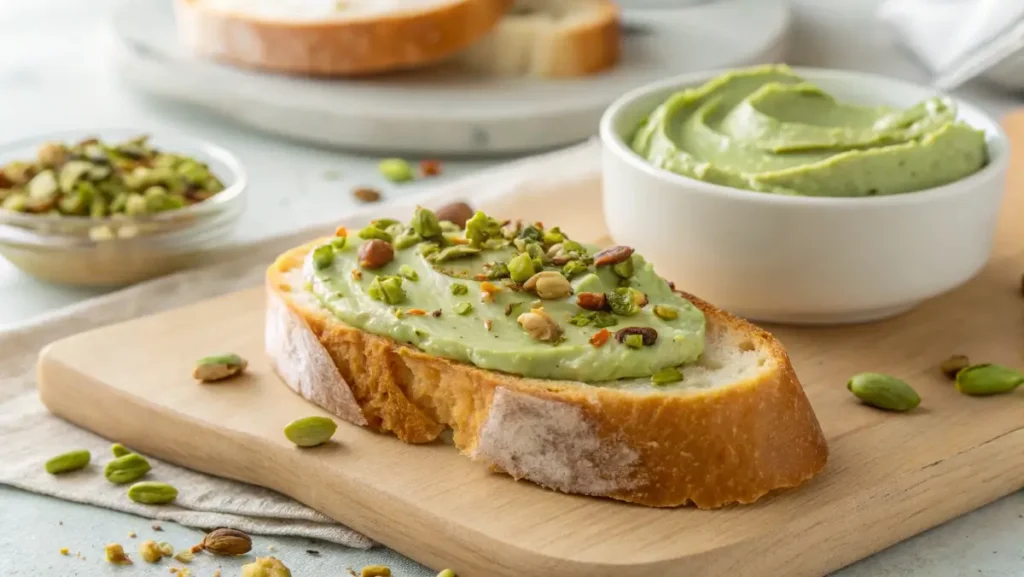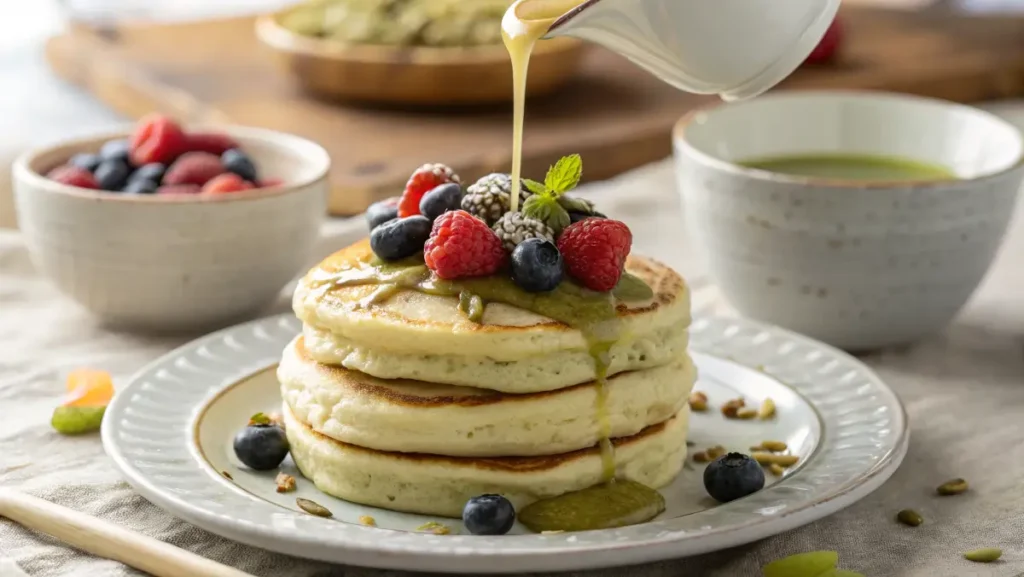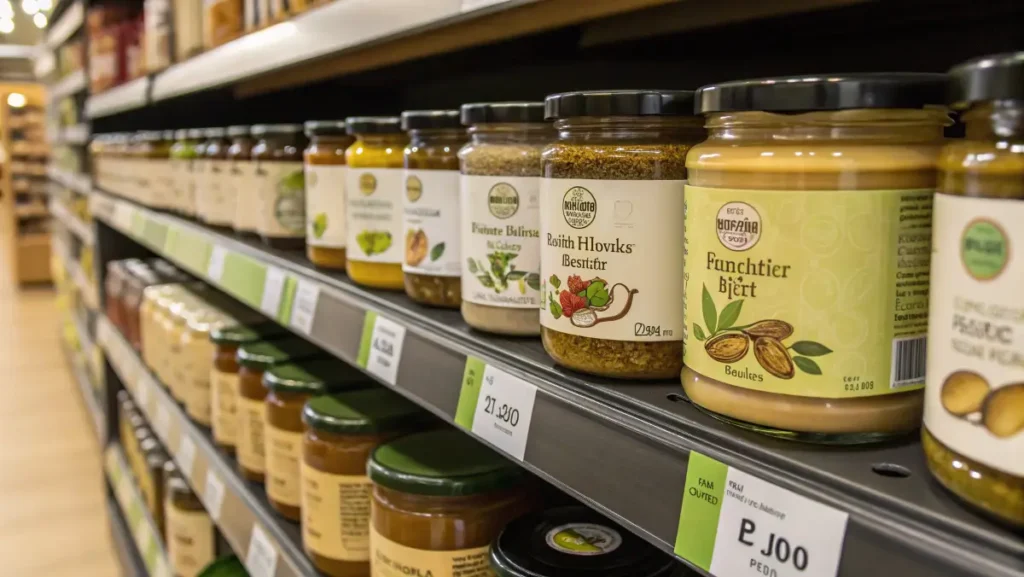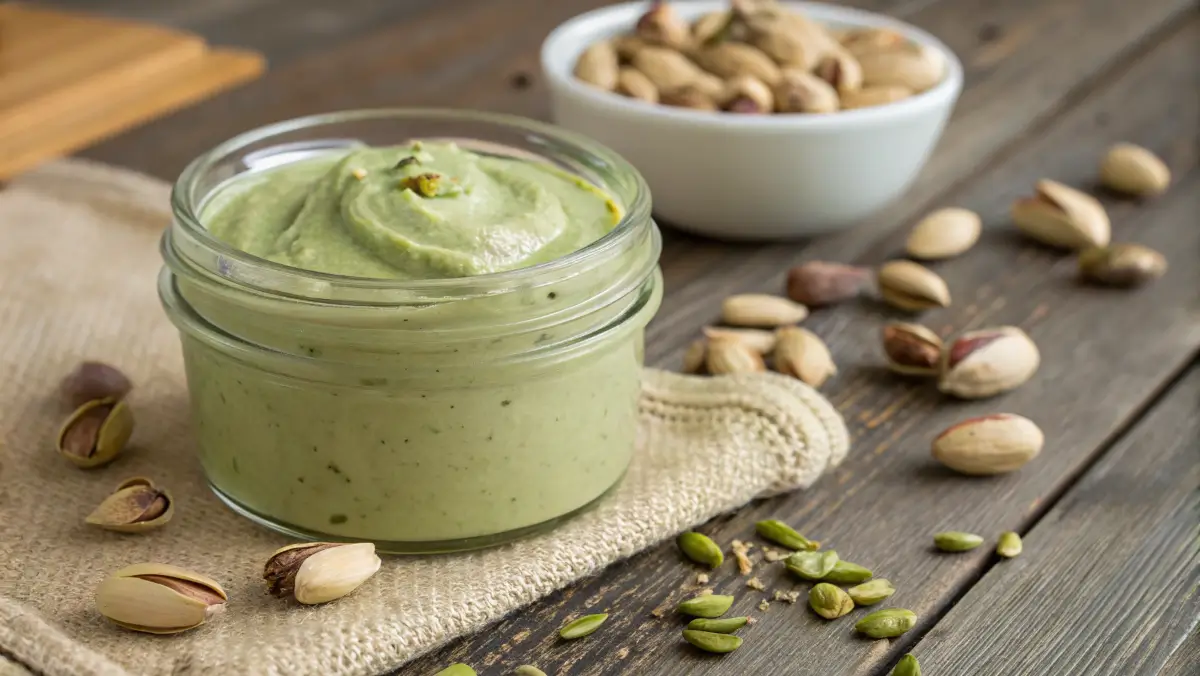Pistachio Butter: The Ultimate Guide to Benefits, Uses, and Comparisons
Pistachio butter is a rich, creamy spread packed with heart-healthy fats, plant-based protein, and antioxidants. Its unique flavor and vibrant green color set it apart from other nut butters. In this guide, discover its benefits, how it compares to peanut butter, why it costs more, and creative ways to use it every day.
Looking for inspiration? Try exploring our gluten-free soft pretzels recipe to pair with pistachio-butter for a delightful snack.
Table of Contents
What Is Pistachio Butter?
Introduction to Pistachio Butter
Pistachio butter is a rich, smooth spread made by finely grinding pistachio nuts into a thick paste. Unlike regular peanut butter, its natural green hue comes from the pigments in pistachios. It has a unique taste—mildly sweet, earthy, and nutty—that distinguishes it from other nut butters. Whether you’re slathering it on toast, mixing it into oatmeal, or adding it to smoothies, pistachio-butter adds an elevated, gourmet flair to everyday dishes.
Because pistachios are rich in essential nutrients like healthy fats, protein, and antioxidants, pistachio butter is often seen as a premium, health-focused choice for those seeking plant-based spreads.
How Pistachio Butter Is Made
The process of making pistachio-butter is quite simple but requires quality ingredients and attention to detail to preserve flavor and nutrition. Here’s a breakdown of how it’s typically made:
| Step | Process |
|---|---|
| 1. Sourcing Pistachios | High-quality pistachios (often roasted and shelled) are selected. |
| 2. Roasting (optional) | Pistachios may be lightly roasted to deepen the flavor and enhance the natural oils, making them easier to grind. |
| 3. Grinding | The pistachios are finely ground using a high-speed food processor or stone grinder until they release their oils and form a paste. |
| 4. Optional Additions | Some brands or homemade recipes may add a pinch of salt, a dash of sweetener (like honey or maple syrup), or even spices. |
| 5. Packaging | The finished pistachio butter is jarred and sealed for freshness. |
There are variations between raw pistachio-butter (made from unroasted nuts) and roasted pistachio-butter. The former offers a milder taste, while the latter delivers a deeper, more robust flavor.
Discover great ideas like our easy protein overnight oats to pair with pistachio-butter for a satisfying breakfast.
Nutritional Profile of Pistachio Butter
Key Nutrients in Pistachio Butter
Pistachio butter isn’t just delicious — it’s packed with nutrients that can fuel your body in a wholesome way. A typical two-tablespoon serving of pistachio-butter provides about 180-200 calories, but those calories come loaded with beneficial fats, protein, and essential vitamins and minerals.
Here’s a quick look at what makes pistachio-butter a nutritious choice:
| Nutrient | Amount (per 2 tbsp) | Benefits |
|---|---|---|
| Healthy fats (mostly monounsaturated) | ~14g | Supports heart health, reduces bad cholesterol |
| Protein | ~6g | Aids in muscle repair and satiety |
| Fiber | ~3g | Promotes digestion and fullness |
| Vitamin B6 | 25% DV | Boosts brain health and energy metabolism |
| Magnesium | 15% DV | Helps with nerve function and bone health |
| Potassium | 8% DV | Regulates fluid balance and heart function |
| Antioxidants (lutein, zeaxanthin) | — | Supports eye health and fights free radicals |
Unlike some other nut butters that may be loaded with added oils or sugar, high-quality pistachio butter is often just pistachios — pure and simple.

Is Pistachio Butter Good for You?
Absolutely! Pistachio butter is a fantastic option for those seeking a nutrient-dense spread that fits into various healthy eating patterns. The monounsaturated fats in pistachios are known to support heart health by helping lower LDL (bad) cholesterol levels while boosting HDL (good) cholesterol.
Additionally, pistachio-butter provides plant-based protein, which is excellent for vegetarians, vegans, and those cutting down on animal products. The fiber content helps with digestion and keeps you feeling full longer, which can be useful for weight management.
What really sets pistachio butter apart is its rich supply of antioxidants like lutein and zeaxanthin — compounds that play a role in protecting your eyes from oxidative damage. These antioxidants, combined with vitamin B6 and magnesium, make pistachio-butter not just tasty, but genuinely good for your overall wellness.
Don’t miss our delicious carnivore diet recipes if you’re curious about balancing different dietary choices while enjoying spreads like pistachio-butter.
Pistachio Butter vs. Other Nut Butters
Pistachio Butter vs. Peanut Butter
When comparing pistachio butter to peanut butter, several differences stand out in terms of nutrition, taste, and versatility. While both spreads offer healthy fats and protein, pistachio-butter typically contains more monounsaturated fats — the kind associated with better heart health. Peanut butter, on the other hand, often contains slightly more protein per serving (around 8 grams vs. pistachio-butter’s 6 grams).
Taste-wise, pistachio butter provides a delicate, subtly sweet flavor with a rich, earthy undertone, while peanut butter leans toward a bolder, more roasted taste. If you’re looking for a spread that offers a unique flavor and beautiful green color for dishes and snacks, pistachio-butter is hard to beat.
From an allergen perspective, peanuts are among the top food allergens in the U.S., whereas pistachio allergies are less common (though still possible). Because of this, pistachio-butter may be a suitable option for individuals with peanut sensitivities—though it’s important to consult a healthcare professional beforehand.
Here’s a quick comparison table:
| Nutrient / Feature | Pistachio-Butter | Peanut Butter |
|---|---|---|
| Protein (per 2 tbsp) | ~6g | ~8g |
| Healthy fats | Higher in monounsaturated fats | Balanced mono- and polyunsaturated fats |
| Fiber | ~3g | ~2g |
| Taste | Sweet, mild, earthy | Bold, roasted |
| Color | Green | Brown |
| Common allergen? | Less common | Very common |
Pistachio Butter vs. Almond, Cashew, and Other Nut Butters
Pistachio butter also holds its own when stacked against almond, cashew, and other specialty nut butters. Almond butter, for example, is often praised for its high vitamin E content and heart-healthy fats. Cashew butter is naturally sweeter and creamier but has slightly less fiber and protein compared to pistachio-butter.
Pistachio-butter shines in its unique balance of nutrients, vibrant color, and distinct flavor profile. Here’s how it compares:
| Nut Butter | Protein | Notable Nutrients | Taste Profile |
|---|---|---|---|
| Pistachio Butter | ~6g | B6, lutein, magnesium | Earthy, sweet, rich |
| Almond Butter | ~7g | Vitamin E, magnesium | Mild, slightly sweet |
| Cashew Butter | ~5g | Iron, zinc | Sweet, creamy |
| Hazelnut Butter | ~4g | Vitamin E, folate | Sweet, nutty |
| Walnut Butter | ~5g | Omega-3 fats | Slightly bitter, rich |
Each of these nut butters offers something unique. However, if you’re seeking an option that delivers both gourmet flair and health perks, pistachio-butter is a winning choice.
Looking for more ideas? Don’t miss our delicious smoked salmon brine recipe for a savory dish that pairs beautifully with nutty spreads.
Why Is Pistachio Butter So Expensive?
Factors Affecting Pistachio Butter Price
If you’ve ever browsed the nut butter aisle and done a double-take at the price of pistachio butter, you’re not alone. Pistachio butter often costs significantly more than peanut butter, almond butter, or even cashew butter — and there are several good reasons for that.
First, pistachios themselves are one of the most expensive nuts on the market. Why? Pistachio trees require several years to reach maturity and start bearing nuts—typically around five to seven years. Once they do, the yield can be inconsistent, with alternating “on” and “off” years of productivity.
In addition, pistachio farming is resource-intensive. Pistachio trees thrive in specific climates — mainly in places like California, Iran, and parts of the Mediterranean — and require plenty of water, which adds to the cost of production. The labor involved in harvesting and shelling pistachios is also greater compared to some other nuts.
On top of that, turning pistachios into butter takes a lot of nuts. Because pistachios are small, it takes more volume to produce a jar of butter than, say, peanuts or almonds. Add the cost of processing, packaging, and distributing a premium, small-batch product, and it’s easy to see how prices climb.
Here’s a snapshot of key price factors:
| Factor | Impact on Price |
|---|---|
| Slow-growing trees | Limited supply, higher costs |
| Water and climate needs | Higher farming expenses |
| Labor-intensive harvest | Increases production costs |
| High nut-to-butter ratio | More raw material needed |
| Premium positioning | Often marketed as gourmet |
Is Pistachio Butter Worth the Price?
That higher price tag may make you pause — but for many, pistachio butter is worth every penny. Beyond its unique flavor and creamy texture, pistachio-butter provides a nutrient-dense alternative to more common nut butters. If you value variety in your diet, seek gourmet or artisanal products, or want to incorporate more plant-based healthy fats and antioxidants, pistachio-butter is a great investment.
Plus, a little pistachio-butter can go a long way. Its rich flavor means you don’t need to use large amounts to enhance a dish, whether you’re spreading it on toast, blending it into a smoothie, or drizzling it over desserts.
Discover great ideas like our peanut butter overnight oats — and try swapping in pistachio-butter for a luxurious twist.
How to Use Pistachio Butter

Creative Culinary Uses
Pistachio butter isn’t just for spreading on toast — though it certainly shines in that role. Its rich, nutty, and slightly sweet flavor makes it one of the most versatile nut butters in the kitchen. Whether you’re aiming for sweet or savory, pistachio-butter delivers.
Here are some delicious ideas to get you started:
- Breakfast booster: Swirl pistachio-butter into your morning oatmeal, yogurt bowls, or overnight oats for added creaminess and a pop of flavor.
- Smoothie enhancer: Add a spoonful to green smoothies, banana-based blends, or berry shakes for natural richness.
- Baking magic: Use pistachio butter in cookies, muffins, or even as a filling in pastries and cakes.
- Savory sauces: Whisk pistachio-butter into dressings for salads or grain bowls, or mix it into sauces for grilled meats and roasted veggies.
- Dip or drizzle: Warm it slightly and drizzle over ice cream, pancakes, or roasted sweet potatoes for a gourmet touch.
Looking for inspiration? Try pairing pistachio-butter with our delicious smoked cream cheese for a savory spread idea.
Simple Pistachio Butter Recipes
If you’re ready to get hands-on in the kitchen, here’s an easy pistachio-butter recipe that brings out the best in these vibrant nuts.
Homemade Pistachio Butter
| Ingredients | Amount |
|---|---|
| Shelled pistachios (raw or roasted) | 2 cups |
| Sea salt (optional) | 1/4 teaspoon |
| Honey or maple syrup (optional, for sweetness) | 1 teaspoon |
Instructions:
- Add pistachios to a food processor.
- Blend for 5 to 10 minutes, pausing to scrape the sides as needed, until the pistachios release their oils and turn into a smooth, creamy spread.
- Add salt and sweetener if desired, then pulse to combine.
- Store in a jar in the fridge for up to 2 weeks.
Quick snack idea: Slather pistachio butter on rice cakes or gluten-free crackers, then add sliced bananas or strawberries on top.
Don’t miss our gluten-free king cake — drizzle pistachio butter over a slice for a decadent twist!
Buying Pistachio Butter
Where to Buy Pistachio Butter (Including Walmart Availability)
Pistachio butter is gaining popularity, and you can now find it in many places — both online and in brick-and-mortar stores. If you’re shopping in person, check the natural foods aisle or the nut butter section at major supermarkets like Whole Foods, Trader Joe’s, or specialty food markets.
And yes — Walmart sells pistachio-butter! Typically, it’s available in the organic or gourmet foods section. Availability can vary by location, so it’s smart to check online before heading out. Walmart’s website often features pistachio-butter options you can order for home delivery or store pickup.
For online shopping, you’ll find a broader selection on Amazon, Thrive Market, and websites dedicated to nut butters and gourmet foods. Shopping online gives you access to brands that focus on small-batch, organic, or artisanal pistachio-butter.
Discover great ideas like our cottage cheese desserts to pair with pistachio butter for a unique sweet treat.

How to Choose High-Quality Pistachio Butter
Not all pistachio butters are created equal. When shopping, here’s what to look for:
- Ingredients list: The best pistachio butter contains just one ingredient — pistachios. A pinch of salt is okay, but steer clear of added oils, sugars, or preservatives.
- Color and texture: High-quality pistachio-butter should have a natural green hue and a smooth, creamy texture. A little oil separation on top is normal — just give it a stir.
- Organic or non-GMO certification: If you prefer organic foods, look for these labels on the jar.
- Packaging: Choose glass jars or BPA-free plastic for safer storage.
A quick pro tip: buy smaller jars at first to ensure you love the taste and texture of a particular brand before committing to a larger size.
Check out our gluten-free sourdough bread — a perfect base for your pistachio-butter spread.
Storage and Shelf Life
Does Pistachio Butter Need Refrigeration After Opening?
Once you crack open a jar of pistachio butter, you might wonder — does it belong in the fridge or the pantry? The answer depends a bit on how soon you plan to use it.
If you’ll finish the jar within a couple of weeks, storing pistachio-butter in a cool, dark pantry is generally fine. The natural oils in pistachios are relatively stable in the short term. However, if you want to keep pistachio butter fresh for longer — say, a month or more — refrigeration is your best bet. Chilling the jar slows down the oxidation process that can cause the nut oils to turn rancid.
Keep in mind that refrigerating pistachio-butter may firm up its texture. Just let it sit at room temperature for a few minutes or give it a good stir before spreading.
Signs Pistachio Butter Has Gone Bad
Nobody wants to take a bite of nut butter only to realize it’s past its prime. Here’s how to tell if your pistachio butter has gone bad:
| Sign | What it Means |
|---|---|
| Off smell | A sour, bitter, or paint-like odor is a red flag that the oils have oxidized. |
| Strange taste | If the butter tastes bitter or stale, it’s time to toss it. |
| Unusual texture | While some oil separation is normal, mold or unusual clumping isn’t. |
| Color change | Pistachio butter may darken slightly over time, but significant color changes could signal spoilage. |
Pro tip: Always use a clean spoon when scooping pistachio butter to reduce the chance of introducing bacteria that can shorten its shelf life.
Looking for inspiration? Try our homemade rhubarb jam as a tangy partner to pistachio butter on toast.
Pistachio Butter for Special Diets
Pistachio Butter in Vegan and Plant-Based Diets
Pistachio butter is naturally vegan, making it a fantastic addition to plant-based meal plans. Since it’s made from pistachios alone (or with minimal additions like salt or natural sweeteners), it fits seamlessly into vegan diets without the need for substitutions.
This creamy, green spread brings more than just flavor — it provides valuable nutrients often prioritized in plant-based eating. With plant-based protein, heart-healthy fats, and a variety of vitamins and minerals, pistachio-butter can help round out vegan breakfasts, lunches, and snacks. Swirl it into oatmeal, spread it on sourdough, or drizzle it over roasted veggies for extra richness and satisfaction.
Looking for inspiration? Try pairing pistachio-butter with our vegan breakfast burrito recipe for a nutritious morning meal.
Pistachio Butter for Keto, Paleo, and Gluten-Free Diets
Pistachio butter also works beautifully in keto, paleo, and gluten-free lifestyles. Let’s break it down:
- Keto: With a low carbohydrate content (about 5-6g of carbs per 2 tablespoons, including 3g of fiber), pistachio butter can fit into a keto meal plan in moderation. Its fats come mostly from monounsaturated sources, which align well with keto’s focus on healthy fats.
- Paleo: Since pistachio-butter is made from whole, minimally processed nuts, it checks the box for paleo followers. Just be sure the version you choose is free of added sugars and oils to stay within paleo guidelines.
- Gluten-free: Pistachio-butter is naturally gluten-free. It’s a safe spread option for those with celiac disease or gluten sensitivity — just double-check that the brand you buy is produced in a gluten-free facility if cross-contamination is a concern.
Pistachio-butter can add flavor and nutrition to recipes across these dietary plans, from fat bombs to energy bites to salad dressings.
Don’t miss our keto cottage cheese egg pizza crust — a great base topped with pistachio butter for a creative twist!
Conclusion
Pistachio butter isn’t just a luxurious treat — it’s a nutrient-rich, versatile spread that can fit into a wide range of diets and dishes. From its heart-healthy fats and plant-based protein to its subtle, gourmet flavor, pistachio butter earns its place on your pantry shelf despite the higher price tag. Whether you’re using it in breakfasts, desserts, or savory meals, it offers a delicious way to enhance your nutrition naturally.
Looking for inspiration? Try our irresistible banana waffles topped with pistachio-butter for your next brunch.
FAQs
Is pistachio butter good for you?
Yes, pistachio butter is good for you when enjoyed in moderation. It’s rich in heart-healthy monounsaturated fats, plant-based protein, fiber, and key nutrients like vitamin B6, magnesium, and antioxidants. These compounds support heart health, aid digestion, and contribute to overall wellness. Plus, pistachio butter is naturally vegan and gluten-free, making it a versatile, nutrient-dense spread.
Is pistachio butter better than peanut butter?
Both pistachio butter and peanut butter offer health benefits, but pistachio-butter stands out for its higher content of monounsaturated fats and unique antioxidants like lutein and zeaxanthin, which support eye health. While peanut butter often provides slightly more protein per serving, pistachio-butter delivers a more delicate, gourmet flavor and a different nutrient profile. The best choice depends on your dietary goals and taste preferences.
Why is pistachio butter so expensive?
Pistachio butter costs more because pistachios themselves are expensive to grow. Pistachio trees take years to mature, require specific climates, and need considerable water and labor for harvesting. On top of that, it takes a large volume of pistachios to produce a single jar of butter, contributing to the premium price tag.
Does Walmart sell pistachio butter?
Yes, Walmart does sell pistachio butter, both in stores and online. Availability can vary by location, but you’ll typically find it in the natural or organic foods section. Walmart’s website often provides options for home delivery or store pickup.
Does pistachio butter need to be refrigerated after opening?
While pistachio butter can be stored at room temperature for short periods (up to a couple of weeks), refrigeration is recommended if you want to keep it fresh longer. Chilling helps slow oxidation and prevents the natural oils from going rancid. Just remember — cold pistachio-butter might firm up, so let it sit out briefly or stir before spreading.
What’s the best kind of nut butter?
The best nut butter depends on what you’re looking for! Pistachio butter is ideal if you want a nutrient-rich, antioxidant-packed spread with a gourmet taste. Peanut butter is affordable, widely available, and higher in protein. Almond, cashew, and walnut butters each have their own health perks. Consider taste, nutrition, and dietary needs when making your pick.

